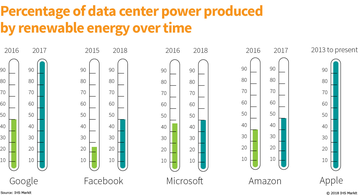Green energy adoption by data center operators is on the rise, a trend largely bucked by hyperscale providers, but some companies have further to go before they reach total independence from fossil fuels, according to a study published by IHS Markit.
According to the report, between two and three percent of developed countries’ electricity consumption is currently attributed to data centers. It suggests (and it comes as no surprise) that the reasons behind the adoption of renewables are mostly monetary, as a transition to green energy allows for the reduction of operational expenses and the potential for grants and tax exemptions.
Green is the new black
Further, companies have come under public scrutiny for their excessive energy us and the impact they may have on the local grid, repeatedly having been called out by ecological activist group Greenpeace, sometimes bringing planned developments to a halt.
Apple met its goal of reaching 100 percent green energy use in its data centers five years ago, and although Google was slightly late to the party, it successfully did the same thing in December last year, up from 50 percent of renewable energy use in 2016.
But Facebook, Microsoft and Amazon have yet to increase the share of green energy on which to run their data centers, all sourcing only half of it from renewable sources.
That being said, Microsoft’s data centers have been carbon neutral since 2014, when it managed to offset 100 percent of its electricity usage from non-renewable sources using renewable energy certificates (REC), and both Amazon and Facebook have expressed their intention to increase their use of renewables, albeit in vague terms.
Unsurprisingly, the report notes that the two most popular onsite renewable energy generation means are solar and wind power, as opposed to hydroelectric and geothermal generation, as they produce a lot of energy and are relatively easy to implement.
Offsite energy generation, however, generally through power purchasing agreements (PPAs), still remains the preferred method of sourcing renewable energy, as costs tend to be lower and allow developers to plan facilities anywhere without being limited by the specific conditions needed to produce renewables.
Another element of note is that as well as considering renewable energy adoption, companies have sought to reduce their energy costs by implementing more efficient equipment in their facilities. These include alternative energy storage, such as lithium-ion batteries and fuel cells, and means of removing heat using less energy, using free cooling, for instance.

